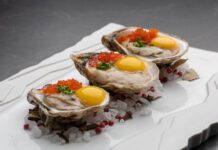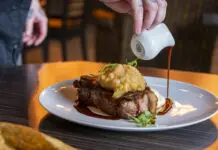One of the smooth-jazz radio hits of the summer just past was Tulsa-based saxophonist Grady Nichols’ “London Baby!” And, as they say in the music business, the song has legs. At this writing, after nearly half a year on the Billboard magazine Smooth Jazz Chart, “London Baby!” was still getting spun regularly on radio stations and internet outlets around the world.
It’s certainly the biggest single of Nichols’ musical career, which stretches back to the mid-‘90s. And what makes that success particularly interesting is that he admits “London Baby!” wasn’t “the obvious choice, by any means, to go on jazz radio.”
“It’s more of an aggressive kind of song,” he explains. “There’s even distorted guitar. Smooth jazz is typically just that, smooth. This song is groove-oriented, which is the big thing for radio, but it’s a little more on the aggressive side than what you’d normally hear.
“Now, it’s considered a ‘recurrent’ on the Billboard Jazz Chart, and last week it was the No. 2 recurrent,” he adds. “It’s been really well received, and I think it’s because the environment with jazz radio is a little different than it was a few years ago. Now, they like things that are a little bit different.”
Listeners who enjoy the same quality in their smooth jazz should be delighted by Destinations, Nichols’ sixth disc, which builds on the musical stretching and experimentation that marked his last CD, 2008’s Take Me with You.
“This one is basically a continuation of that concept,” he says. “There’s still a lot of jazz in it, you know, but we really tried to take the approach even further by having the saxophone be the voice of all these songs. We really tried to approach it from a singer-songwriter perspective, where it wasn’t, ‘Okay, let’s take 32 bars and play every riff we know. Instead, here’s the verse – let’s make it count. Here’s the chorus. Make it count.’ The songs are structured like pop songs.”
For Take Me with You, Nichols enlisted artist and writer Zac Malloy – a man more associated with pop, rock and country music – as a producer. The Tulsa saxophonist followed down that same road with Destinations, thanks in part to his Nashville-based manager, Paula Crafton.
“I had seen (multi-instrumentalist and background vocalist) Chris Rodriguez perform with Kenny Loggins on a DVD, and he was killer on it,” Nichols recalls. “Then, I saw him with Keith Urban when they came to the BOK Center. I was talking to Paula, and I said, ‘You know, I really want to keep stretching what we do with the sax, but I need a producer who can stretch with me.’ She suggested Chris.
“I said, ‘If you’ve got a way to get to Chris, I’ll tell you right now that would be great.’
“I was a fan of his then,” adds Nichols. “Now, I’m an even bigger fan. He was the perfect guy to produce this record, because he’s played in all these different worlds. He’s on tour with Kelly Clarkson right now, but when he and I worked together, he’d just stopped touring with Keith Urban and LeAnn Rimes. He’d done pop, he’d done country, and before Keith Urban he’d toured for 20 years with Kenny Loggins.”
With Rodriguez on board as producer, Nichols headed for Nashville, where his manager had once again come through for him. The studio she booked for the recording sessions is now known as Ben’s Studio, for its current owner, rocker Ben Folds. But for decades, musicians and fans referred to it as Bradley’s Barn, where famed country-music producer Owen Bradley, as well as other luminaries, created legendary recordings.
“Elvis recorded there,” Nichols points out. “Outlaw country got its start there, with Waylon Jennings and Johnny Cash. I had wanted to do the record in Nashville, just to vibe off what that would be like, and I was intrigued by the history of that studio, and the fact that it was big.
“I took my band. We loaded up, drove to Nashville, schlepped all of our gear, and just camped out in the studio for a couple of days and worked all day – and it was a pleasure.” He laughs. “We were really able to concentrate on a lot of things that we hadn’t necessarily concentrated on before. We had several engineers in the studio, a main engineer and assistant engineers, and we worked on getting different sounds.
“Because it was so huge, all of us could play together,” he adds. “In most studios, you’ve got adjoining rooms, smaller rooms. Everybody can track together, but you’re not seeing the other players. We were all able to be together. I was in my sound booth, but I could see Chuck (Tottress, his bassist). I could see David (John, his guitarist) and Mike (Wilson, his keyboardist). I could see Jo (Nathan Watkins, his drummer). We played together, and it was such a blast.”
Nichols and producer Rodriguez also put, on various cuts, strings, steel drums, and even a banjo and steel guitar –musical ingredients not often found on most smooth-jazz tracks.
“Well, we didn’t step into another universe by any means,” Nichols says. “The style of what we’re doing was still the same. But the environment changed in such a way that it greatly enhanced the material.
“We got to work with real (as opposed to synthesized) strings. We hired some Nashville guys to do strings, and they did a fantastic job. It was just a great experience, because everybody we worked with in Nashville was so excited about what we were doing. It was something different for them, and they all had ideas to contribute. That’s exactly what you want. You want everybody to take ownership of the music.”
Except for covers of Journey’s “Faithfully” and Keith Urban’s “Only You Can Love Me This Way,” Destinations contains all original tunes. For those of us who live in and around the town Nichols calls home, the most immediately arresting track is one called “Tulsa,” a number Nichols wrote with Rodriguez and John. Some reviews have commented on its country elements, but “Tulsa” also contains echoes of other types of music associated with our state. Not surprisingly, that’s exactly what Nichols was going for.
“A lot of people have asked me over the years, ‘Why do you live in Tulsa? Why did you never get up and leave and go to Nashville or L.A. or wherever?’” he says. “Well, I love Tulsa. It’s a wonderful place to live. It’s a wonderful place to raise a family and build a life, and it’s been very good to me. Just by being here, I’ve had opportunities that I wouldn’t have had if I’d lived somewhere else. I wouldn’t have gotten to open for Ray Charles or Pavarotti, or play with the Beach Boys.
“Tulsa has always been very, very supportive of my music and me,” he adds, “and I wanted to have something that kind of contributed to the legend of the Tulsa Sound, to put my hat in the ring with all the guys who had gone before – Leon (Russell) and Clapton and J.J. Cale, that whole history Tulsa has with music. I wanted to put something in that was a purposeful hybrid of a lot of different styles I think represent Tulsa. It’s a unique town, and I love it.”






















